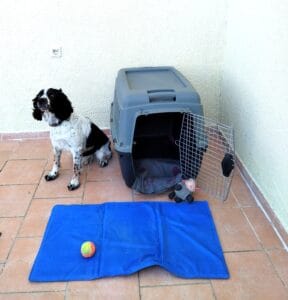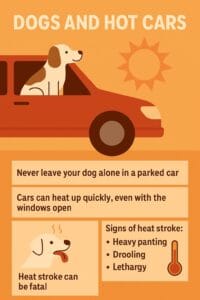Last Updated on 27/07/2025 by Claire Coney
Travelling with a dog in the car can be a rewarding experience for pet owners. Whether you’re planning a weekend trip or a long journey, having your furry friend along can make the adventure more enjoyable. However, travelling with dogs requires careful planning and the right gear to ensure a safe and stress-free experience for both you and your pet.
As a dedicated dog parent, I’ve spent many hours on the road with my two pups—Abigail, a lively Cairn Terrier, and Charlie, an adventurous English Springer Spaniel. The sound of car keys sends them into excited zoomies! We’ve travelled from quiet hikes to family holidays, learning what it takes to enjoy a smooth road trip with dogs.

In this guide to travelling with a dog in the car, I’ll share practical tips, essential items to pack, and advice on keeping your dog safe and comfortable. Whether you’re an experienced road-tripper or taking your first trip with your dog, this guide will help make your journey enjoyable for all.
Readers like you support The Fido Trail! If you shop through our links, I might earn a little commission, which helps me create more adventures for Charlie, Ellie, Murphy and Archie and share dog-friendly travel tips. Don’t worry—you won’t pay more. Thanks for your support!
Section One: Preparing For Travelling with Your Dog in The Car
Travelling with your dog in the car requires thoughtful planning for their safety and comfort. I follow key steps when travelling with my dogs in the car. These include visiting the vet, using proper restraints, packing essential supplies, and gradually acclimating my dogs to the vehicle with short, positive trips. You can follow the steps for a successful road trip, too!
1. Visit a Vet Before Travelling In The Car with a Dog
I take my dogs to the vet to ensure they are healthy before we travel, bringing their medical records with me. This is especially important for Charlie, who has a health condition. I make sure that my dogs’ vaccinations and microchips are up to date.
Pro Tip: If you are concerned about motion sickness, you can also take this opportunity to talk to your veterinarian about managing the situation before it happens.
2. Dog ID tags
I ensure my dog’s ID tags are up to date before travelling with Abigail and Charlie in a car.
If Fido becomes lost in unfamiliar surroundings, someone can contact you if they find him. I am sure you will be overjoyed to be reunited with your best furry friend.
Pro Tip: The tag should have your home address and phone number.
3. Choosing The Right Restraint For Travelling With A Dog In The Car
The safety of my dogs is my top priority. I select the most appropriate restraint to secure my dogs in our vehicle based on circumstances and the needs of Abigail and Charlie.
Your options include a carrier, back seat hammock, travel harness, dog crate, or boot guard. It’s crucial to prevent your dog from roaming freely in the car. This can be dangerous for both the pet and the driver. You can find out more about the travel crate set-up in my guide.

4. Pre-trip Training For Travelling With A Dog In The Car
Training is key to success when travelling with my dogs in our vehicle! When I first began taking Abigail and Charlie on car trips, I kept the journeys short and chose fun destinations like the beach, woods, or parks. I closely observed their reactions to being in the car and gradually extended the duration of our travels. This approach has significantly reduced their travel anxiety and made our vehicle a familiar and safe space that both dogs enjoy.
If your dog isn’t used to long car rides, consider training to prepare them for the journey. Reward-based training can help them associate the car with positive experiences.
5. Essential Packing For Travelling With A Dog In The Car
I write a checklist of everything I need when travelling with my dogs in the car. Here are some essential items I take:
- Food, water, and bowls
- Medication, health records, and immunisation documents
- Plenty of poop bags and a poop bag holder
- A doggy first aid kit for emergencies
- Favourite toys
- A blanket and bed to provide them with a sense of security
- Leash and collar or harness for walks
- A crate or carrier for travel and a safe space
- Grooming supplies like brushes and nail clippers
- Treats for positive reinforcement
- Identification tags with your contact information
- Cooling vest or sweater, depending on the climate and your dog’s needs
6. Planning Your Route with Your Dog in Mind
When planning a road trip with your furry friend, it’s essential to consider their needs.
I use websites like BringFido as they have an extensive directory of pet-friendly places. It includes hotels, restaurants, and dog parks. This will ensure a comfortable journey for both you and your pet.
Additionally, some rest stops have gone the extra mile to accommodate pets. They provide fenced dog parks and other amenities to make your travel experience more enjoyable. Always remember to check the pet policies of accommodations in advance to ensure a smooth and stress-free trip.
Section Two: During The Car Trip With Your Dog
Keeping my dogs comfortable during car travel is crucial for a smooth journey. Here are some tips to ensure your four-legged friend stays relaxed.
1. Don’t Leave Your Dog In The Car When It’s Hot!

Never leave your dog in the car alone in the heat. The rate at which a vehicle can heat up is alarming. If it is sunny and the temperature outside is 24 °C, within 10 minutes it can reach 38 °C inside the car. Within 30 minutes, it will be approaching 50 °C.
If you leave Fido in that sort of heat, it will gradually increase his core temperature. Dogs cannot sweat and are unable to cool themselves down quickly enough by panting alone. Once Fido’s core temperature reaches 41.5 °C, his cells will start to break down. Then the enzymes will be destroyed. Remember, dogs die in hot cars! Besides, passers-by may break the window to release the trapped dog to end his suffering.
2. Tips for Travelling With a Dog in the Car During Warm Weather
During holidays, there may be times when it’s necessary to travel with our dogs in warm weather. My husband, Austin, and I typically choose to travel early in the morning, late in the evening, or overnight. These times are generally cooler, making it more comfortable for our dogs, and we also avoid traffic jams!
When we take breaks, either Austin or I will stay in the car with Abigail and Charlie. We park in the shade and open the windows to let in some fresh air. Alternatively, we turn on the air conditioning to keep them cool. Additionally, Abigail and Charlie use cool mats and always have plenty of water to stay hydrated.
3. Use Sunshades or Window Covers
Another way I ensure Abigail and Charlie are comfortable in the car is by using sunshades. This helps block harsh rays and reduce glare. Partially covering the windows can also help minimise visual overstimulation.
4. Don’t Let Your Dog Stick Their Head Out Of The Window!
Fido could knock his head against something if he had his head out of the window. It is also dangerous as Fido might fall out of the window or distract other drivers.

5. Avoid putting Dogs In The Front Seat Of The Car
Dogs can only travel on the front seat of the car if you switch off the passenger-side airbag. Also, move the seat as far back as possible. Airbags are good for humans, but can kill dogs. However, it is safer for your dog to travel in the back of the car. The dog is also less likely to distract you when you are driving.
6. Keep the Ride Smooth and Calm
Drive gently to ensure a smooth ride, avoiding sudden stops or sharp turns. Select well-paved routes and lower noise levels by turning off loud music.
7. Managing Car Anxiety or Motion Sickness
To prevent motion sickness, it’s important to recognise the signs and take preventive measures. Before a trip, I typically feed Abigail and Charlie a light meal three to four hours beforehand. Throughout the journey, I ensure they have plenty of water. I also keep them happy and comfortable by bringing along their favourite toy and blanket.
However, if you are concerned about this, then go to your vet, and they may be able to prescribe medication. Alternatively, try calming tablets. These work well and help Abigail and Charlie relax on long journeys.

Pro Tip: Dogs generally suffer less if they are facing forward when you are driving.
7. Stop Regularly When Travelling With Your Dog in The Car
When planning my journey with my dogs in the car, I always allow plenty of time to stop along the way. Abigail and Charlie need breaks to stretch their legs, go to the bathroom, and have a drink. I typically stop every 2 to 3 hours.
I use a travel water bowl that can be flattened and stored easily. To prevent motion sickness, I only give Abigail and Charlie light snacks or treats during the trip.
It’s important to offer your dog water regularly throughout the journey to keep them hydrated.
Most service stations have a dog walking area, or you could break up your journey with a trip to the park. You could go out for a short walk or have lunch in a dog-friendly cafe along the way. This will also make the journey easier if you are travelling alone with your dog. Why not make your journey with Fido fun? It is part of your adventure after all.

8. Travelling with a Dog in the Car: Special Considerations
Every dog and journey is unique, and special situations require extra preparation when travelling with a dog in the car. Here are some important tips:
- Multiple Dogs: Ensure each dog has their own space in the vehicle, closely monitor their behaviour, and bring extra supplies to prevent conflicts and reduce stress.
- Puppies: Start with short trips to help them adjust. Use a crate for safety, pack chew toys to keep them occupied, and plan for frequent potty breaks.
- Senior Dogs: Provide orthopaedic bedding for comfort, maintain their routines, bring any necessary medication, and limit long drives to reduce joint strain and fatigue.
- Long-Distance Travel: Research pet-friendly stops along your route. Maintain feeding and walking routines, and have emergency vet contact information readily available.
- Extreme Weather: Keep your dog comfortable in the heat by ensuring proper hydration and using climate control. In winter, provide warm clothing and blankets to keep them cosy.
With a little planning, you can navigate any special situation and ensure a safe, comfortable trip for your furry companion.

9. Travel Regulations by Country or State
Pet travel laws can vary widely depending on where you’re going. Some states and countries have strict rules about restraining dogs in vehicles, while others may require vaccination documentation, import permits, or health certificates, especially if you’re crossing international borders. If travelling internationally, research pet travel regulations for entry, such as rabies vaccination certificates or quarantine periods.
Don’t miss my guide to travelling from the UK to Europe with your dog.
10. UK Law for Travelling With a Dog In The Car
Did you know that if your dog is not restrained in the car, you could be breaking the law?
The Highway Code – Rule 57 States:
‘It’s the driver’s responsibility to make sure pets are restrained in the car. This is so that they cannot distract you while you are driving. This also helps to prevent them from injuring you or themselves if you stop quickly.’
A serious accident could happen if your pet distracted you. This is dangerous driving, and the accident is your fault! You could get charged with ‘driving without proper control’, which comes with a £1,000 fine and three points on your licence. You should also check your insurance policy. Some providers may require you to restrain your pet while driving. It’s always better to be safe than sorry when travelling with a dog in the car.
11. The Go Compare Survey Revealed:
- 40% of pet owners are unaware of the rules about driving with dogs
- 21% dog owners admit to not adequately securing their dog in the car
Pro Tip: Always check the most up-to-date pet travel laws for your destination before you hit the road.

12. Insurance and Emergency Contacts
Be prepared for the unexpected by ensuring you have pet travel insurance, checking if your vehicle insurance covers pets, and keeping a list of emergency vets and your dog’s key information easily accessible in case of emergencies.
13. Arriving at Your Dog-Friendly Destination
Fido will need time to get used to the new smells of the hotel, B&B, or campsite. Also, he will need plenty of naps throughout the holiday for relaxation.
Wrapping It Up
You have learnt a lot about travelling with a dog in a Car safely. Here are some main points to remember:
- How to prepare before the trip
- Safety and restraint options
- Keeping your dog comfortable during the ride
- Managing special situations (puppies, seniors, multiple dogs)
- Legal and safety considerations
- Planning dog-friendly road trips
With these tips, you can travel with a Dog in your Car Safely and have a great time together on your next adventure.
Now I am curious:
Where did you and your dog go? And what kind of dog restraint did you use in your car?
Share your experience in the comments below.
(And if you want more tips on how to Keep My Dog Safe When Travelling in a Car, check out this article.)





